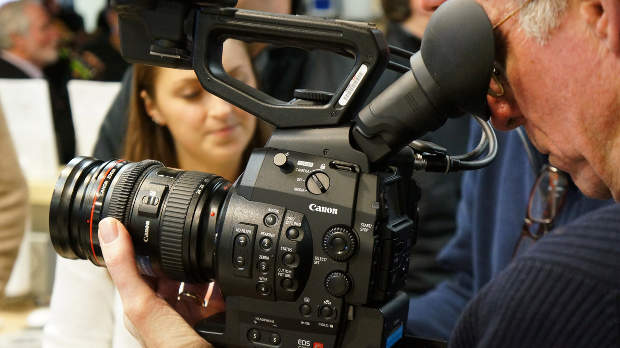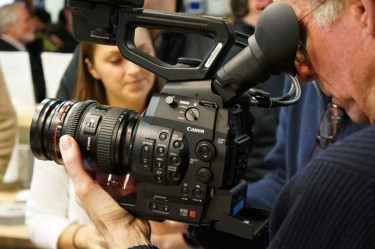 Back to selection
Back to selection
DP’s Discuss The Canon C300

The Canon C300 had a coming out party in Boston last week where Larry Thorpe of Canon presented the camera at an evening event hosted by Rule Boston Camera. A large crowd turned out to hear Larry speak about the camera, and to play with the four demo units that were present.
When the camera was first announced I asked some local DPs for their reaction to it, and I took advantage of this opportunity to get their reactions after seeing the camera in person:
Jeremy Traub is a DP based in Boston who is very familiar with RED cameras, though he’s also shot with the Arri Alexa and even DSLRs.
I still love the shadow details on this camera. I still love the low-light sensitivity of this camera. I’m still worried about the recording media and the limitations; you’re recording in-camera onto CF cards at only 50 Mbps. Or you can record out to the HD-SDI, but that only takes 8-bit on a 10-bit carrier. There’s no way to get the world’s best image quality out of the camera like you can with some other cameras, there’s no 4:4:4 HD-SDI dual link, nothing like that.
Having said all that, what I’m most impressed about tonight, having already seen footage before, is that this camera has a really nice feel in my hands. The controls are really obviously laid out; I’ve got my confidence indicators right on the screen for ASA, color temperature, and wave form. Everything is very beautifully laid out, there’s only a couple of buttons the operator really needs to deal with that set everything you need to know. It’s very obvious how to use it at a glance and it feels really comfortable.
I’m extremely impressed with the low-light sensitivity; I want to return to that. I’m shooting here in this room, which is really dimly lit, at ISO 20,000, f/11, and I’ve got a really nice looking picture. Even at less extreme settings the image quality in very low light is very impressive, and I can’t wait to test this on a bigger screen, and try it out more.

DP Paul Antico has been shooting with the Sony NEX-FS100 for the past few months, but he already plans to sell it and buy the C300:
I’m selling the FS100. It was a great camera, I used it on a recent project and the images looked great, but it was real tough for me to actually work with in the field. First of all, I thought I was going to break it every two minutes, from the beginning I always thought it wasn’t well built. I don’t like the fact that the handle is very chintzy and weak and I have to buy another handle. It’s a bizarre form-factor. The LCD viewfinder is not that good, with the loupe, so you’ve got to use another monitor.
For me, within my price structure, I don’t want to compromise. The other issue I have, a big problem with the FS100, is that it’s not very good with highlights. Everybody’s trying to come up with different picture profiles and different ways to get around the fact that the highlights don’t blow out nicely, they fringe, and there’s just no way around it. I also don’t like working with AVCHD out of the camera. I tried using it natively with Adobe, it worked, but when you put any effects on it, it bogs down. I don’t want to deal with an external recorder.
And then, all of the EF lenses, I can use IS again and I can kind of run-and-gun with it. I can use what I have now and what I might get in the future, I can use those lenses on my Canon SLRs too.
I played with it on a shoulder rig and I actually handheld it, and it’s surprisingly light, but it doesn’t feel like it’s going to fall apart in your hand. And it’s also very ergonomic and has ND filters. Take the FS100, I’ve got to put my variable ND on there, I’ve got to put the matte box on there. But ultimately it’s the image, the image has got a couple more stops of dynamic range. It’s easy to work with and grade, it looks even better than the F3/FS100; at high ISOs it’s got a very organic look, its hard for me to describe. You look at it on the screen, you download the examples and you’ll see that.
The Sony PMW-F3 with S-Log, there’s no doubt it’s an amazing, Alexa-like image. You could argue that both cameras – the C300 and the F3 – when you’re all done, are very similar looking, but you’re going to get that 4:4:4 10-bit advantage, and to some people that’s very important. That extra two stops of dynamic range, depending on what you’re shooting, could be very important. I’m not against renting the F3 to use alongside the C300 in some shots, it all depends.
DP/Editor Rick Macomber shoots news for CBS Boston by day, and independent projects with Canon DSLRs in his spare time:
I’ve seen a lot of the videos on Vimeo, I’ve watched Mobius, I’ve watched the behind-the-scenes, I’ve seen Rodney Charter’s U.K. stream recently. I’ve pretty much seen all the videos about the C300 and I think it lives up to everything that they’ve said about it. It’s light, it has a great feel when you mount it on a rig and shoulder mount it with an EVF against your eye. It’s balanced. In that behind-the-scenes video we saw, they mounted it on a motorcycle, it’s so light, and it shoots so well in low light. It’s so far, I think, the perfect camera for the price, and I’m hoping the price will come down.
Daniel Bérubé is organizer of the Boston Final Cut Pro Group and co-organizer of the SuperMeets. He and his twin brother Don have freelanced with Canon for over 12 years speaking at various events about Canon video cameras and Digital Imaging Solutions, but were not at this event in an official capacity:
I’ve got a Panasonic AF100 right now, and I’m going to buy the EF mount C300 and sell my AF100. The AF100 is a great interview camera, but I’m not ultimately satisfied with it. I bought it to learn more about the camera because at that point in time that was the only large-sensor camera besides what Canon was offering. Working for Canon I wanted to learn more about it so I could be more knowledgeable when having conversations with people who were considering buying it instead of Canon. And I’ve shot with it, but ultimately I’m a Canon guy and I’m not a real big fan of the micro-four thirds format. I did get the Voigtlander .95 lens for the AF100 and it’s a beautiful lens, it’s going to make a great camera for someone. Me, I’m going to go for the C300.
Q: Why not the Red or PMW-F3?
Because I’ve got a ton of EF L lenses. The lens really sing with what I’m shooting now, with my 5D mark II, so I know they are going to do well with the C300. Sure there’s some, I don’t even want to call them limitations, but this is the first camera in the Cinema EOS format and there’ll be more. They’re here to stay, they’re putting a major investment into it, I’ve been to the Hollywood office, it’s beautiful.Q: So at what point did you decide you were going to get one? When it was announced?
In the training, when I got trained on it [just before the announcement.] And also when I was at the Canon launch and saw the footage and saw all the support. After being at the Hollywood office, and seeing what they are doing, that sold me. But it’s not that I’m working for Canon that I’m doing it. It’s because I want to shoot. I want to do some creative projects, and I’ve got some projects that I think this camera would work very well with.

